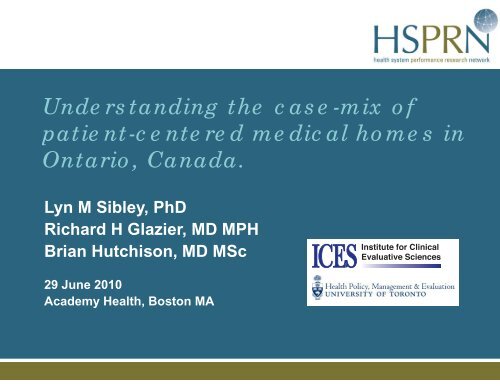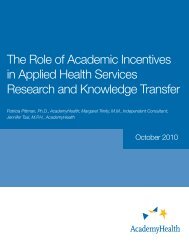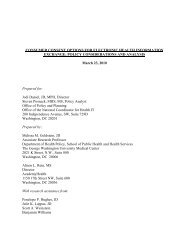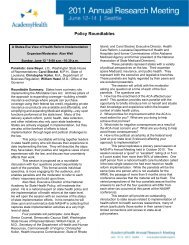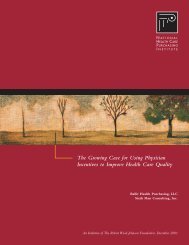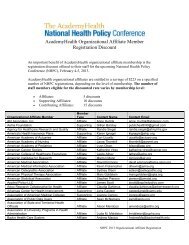Lyn Sibley - AcademyHealth
Lyn Sibley - AcademyHealth
Lyn Sibley - AcademyHealth
Create successful ePaper yourself
Turn your PDF publications into a flip-book with our unique Google optimized e-Paper software.
Understanding di the case-mix of<br />
patient-centered medical homes in<br />
Ontario, Canada.<br />
<strong>Lyn</strong> M <strong>Sibley</strong>, PhD<br />
Richard H Glazier, MD MPH<br />
Brian Hutchison, MD MSc<br />
29 June 2010<br />
Academy Health, Boston MA<br />
leveraging Leveraging the culture of of performance excellence in health in health systems. systems
Health Care in Ontario<br />
• ~13 million population<br />
• Universal insurance<br />
• Equity is a guiding<br />
principle<br />
• Primary care provided<br />
by family physicians<br />
• 25,268 MDs in 2006<br />
– 11,392 FP/GPs<br />
– 13,876 SPs<br />
leveraging the the culture of performance of excellence excellence in health in health systems systems
Primary Care Models in Ontario<br />
• Physician work in groups<br />
• Enroll patients<br />
t<br />
• After-hours clinic and call requirements<br />
• Retention bonuses/penalties<br />
• Pay-for-performance<br />
– diabetes, mental health, heart failure, smoking<br />
cessation<br />
– preventive care (but only if >650 patients<br />
enrolled)<br />
leveraging the culture of of performance excellence in health in health systems systems
Primary Care Models in Ontario<br />
• Enhanced fee-for-service (FFS)<br />
• FHG began in 2003, capitation element ($2/person/month)<br />
• 100% FFS<br />
• largest model<br />
• Capitation<br />
• Team<br />
• older – HSO, PCN<br />
• newer – FHN in 2002, FHO in 2005<br />
• primarily capitation eg $140/person/year<br />
• age-sex adjustment but not health status<br />
• 10% shadow billing<br />
• FHT in 2005, now 150 teams<br />
• multidisciplinary teams<br />
• doctors required to be on capitation ti or salary<br />
leveraging the culture of of performance excellence in health in health systems systems
Patient Centred Medical Home<br />
College of Family Physicians of Canada<br />
Personal Family Physician<br />
Access to a Patient-Centred Team<br />
Coordination of Care<br />
Timely Access to Patient-Centred Care<br />
Appropriate Funding/Remuneration<br />
Quality Improvement and Evaluation<br />
Electronic Information and Communication<br />
American Academy of Family<br />
Physicians<br />
Personal Physician<br />
Physician Directed Medical Practice<br />
Care is Coordinated and/or Integrated<br />
Enhanced Access<br />
Payment Reform<br />
Quality and Safety<br />
Whole Person Orientation<br />
leveraging the culture of of performance excellence in health in health systems systems
Primary Care Models in Ontario<br />
Patient Centred Medical<br />
Home<br />
Enhanced FFS<br />
(FHG)<br />
Capitation<br />
(FHN, FHO)<br />
Team<br />
(FHT)<br />
Personal Family Physician i <br />
Patient-Centred Team<br />
<br />
Coordination of Care <br />
Timely Access <br />
Appropriate Funding <br />
Quality Improvement <br />
Electronic Information<br />
<br />
leveraging the culture of of performance excellence in health in health systems systems
PCMH in Ontario<br />
• Large investment by Ministry<br />
• Little is known about the impact on<br />
patients or physicians<br />
• Equity concerns:<br />
– patient t access<br />
– physician reimbursement<br />
leveraging the culture of of performance excellence in health in health systems systems
Objective<br />
• Characterize the morbidity burden of<br />
rosters.<br />
• Examine variations in roster casemix<br />
between three different types of primary<br />
care model types.<br />
leveraging the culture of of performance excellence in health in health systems systems
Study Sample<br />
• Administrative data collected by the<br />
Ontario Ministry i of Health.<br />
•Physicians who belonged to a primary<br />
care patient enrollment group on March<br />
31, 2009.<br />
• Patients enrolled to physician on March<br />
31, 2009.<br />
leveraging the culture of of performance excellence in health in health systems systems
Johns Hopkins ACG Case-Mix<br />
System<br />
• Adjusted Clinical Group<br />
• Identifies groups of patients within<br />
populations that have similar health care<br />
resource needs<br />
• Based on:<br />
– age<br />
–sex<br />
– combination of minor and major diagnoses<br />
• Widely used to adjust capitation payments<br />
leveraging the culture of of performance excellence in health in health systems systems
1. Ontario ACG Morbidity Index:<br />
• Population of Ontario on March 31, 2009<br />
• N ≈ 13 million<br />
• Diagnosis data<br />
– 1 Year (April 08 – March 09)<br />
– physician billing (ICD-9 codes)<br />
– hospital records (ICD-10 codes)<br />
leveraging the culture of of performance excellence in health in health systems systems
1. Ontario ACG Morbidity Index:<br />
• Relative measure of expected resource<br />
use<br />
• Average cost per ACG<br />
– primary care fee codes<br />
– outliers truncated at ±3SD<br />
• Standardize - divide by population<br />
average<br />
leveraging the culture of of performance excellence in health in health systems systems
2. Roster Casemix: SAMI<br />
• Standardized ACG Morbidity Index (SAMI)<br />
• Assigned to each physician’s roster<br />
• Average ACG weight of all patients on the<br />
roster<br />
• Expected primary care use relative to the<br />
population<br />
p<br />
(Hutchison, Reid)<br />
leveraging the culture of of performance excellence in health in health systems systems
Results: Cohort<br />
• Excluded rosters with < 100 patients<br />
• 5,605 physician rosters<br />
• 574 group practices<br />
• 7,048,187 patients<br />
leveraging the culture of of performance excellence in health in health systems systems
Results: SAMI by Group Types<br />
2.5<br />
2.0<br />
SAMI<br />
1.5<br />
Roster<br />
1.0<br />
Mean = 1.22<br />
1.06<br />
0.99<br />
0.5<br />
0.0<br />
Fee-for-Service Capitation Team Capitation<br />
Overall mean SAMI = 1.14<br />
leveraging the culture of of performance excellence in health in health systems systems
Results: SAMI by SES<br />
1,400<br />
1.5<br />
1,200<br />
1.4<br />
# of Ro osters<br />
1,000<br />
800<br />
600<br />
400<br />
1.3<br />
1.2<br />
1.1<br />
1.0<br />
Mean SAMI<br />
200<br />
0.9<br />
0<br />
24.0<br />
% of Low-Income Patients (Quintiles)<br />
0.8<br />
leveraging the culture of of performance excellence in health in health systems systems
Results: SAMI by SES<br />
1,000<br />
15 1.5<br />
900<br />
800<br />
N<br />
Sami<br />
1.4<br />
700<br />
1.3<br />
# of Ro osters<br />
600<br />
500<br />
400<br />
300<br />
200<br />
100<br />
1.2<br />
1.1<br />
1.0<br />
0.9<br />
SAM MI<br />
0<br />
1 2 3 4 5 1 2 3 4 5 1 2 3 4 5<br />
FFS Capitation Team<br />
% of Low-Income Patients (1= Fewest)<br />
0.8<br />
leveraging the culture of of performance excellence in health in health systems systems
Results: SAMI by Rural/Urban<br />
100%<br />
1.50<br />
ters<br />
% of Ros<br />
90%<br />
80%<br />
70%<br />
60%<br />
50%<br />
40%<br />
30%<br />
20%<br />
10%<br />
% SAMI<br />
1.40<br />
1.30<br />
120 1.20<br />
1.10<br />
1.00<br />
0.90<br />
SAMI<br />
0%<br />
Urban<br />
Rural<br />
0.80<br />
leveraging the culture of of performance excellence in health in health systems systems
Results: SAMI by Rural/Urban<br />
100%<br />
90%<br />
80%<br />
70%<br />
% SAMI<br />
1.5<br />
1.4<br />
1.3<br />
% of Ros sters<br />
60%<br />
50%<br />
40%<br />
30%<br />
20%<br />
10%<br />
1.2<br />
1.1<br />
1.0<br />
0.9<br />
SAMI<br />
0%<br />
Urban Rural Urban Rural Urban Rural<br />
FFS Capitation Team<br />
0.8<br />
leveraging the culture of of performance excellence in health in health systems systems
Key Findings<br />
• Family Health Team rosters had a lower<br />
average morbidity burden, fewer rosters<br />
with a high concentration of low income<br />
patients, and more rural practices.<br />
• The FFS rosters had a higher average<br />
morbidity burden, overall and within each<br />
level l of low-income concentration ti and<br />
rural/urban category.<br />
leveraging the culture of of performance excellence in health in health systems systems
Discussion<br />
• Cross-sectional does not permit<br />
conclusions about causation<br />
• Physicians selected model type based on<br />
their existing practice<br />
•Diagnosis coding in:<br />
– capitation models<br />
– teams<br />
– rural<br />
leveraging the culture of of performance excellence in health in health systems systems
Implications for Policy<br />
• Big concern that there are fewer low<br />
income and high h morbidity patents t in<br />
PCMH.<br />
• Inequity in who benefits from patient<br />
centred medical homes in Ontario.<br />
leveraging the culture of of performance excellence in health in health systems systems
Thank you<br />
<strong>Lyn</strong> M. <strong>Sibley</strong>, PhD<br />
Department of Health Policy, Management, and Evaluation<br />
University sty of Toronto<br />
o lyn.sibley@utoronto.ca<br />
ph: 416-978-5017<br />
fax: 416-978-7350<br />
leveraging Leveraging the culture of of performance excellence in health in health systems. systems


